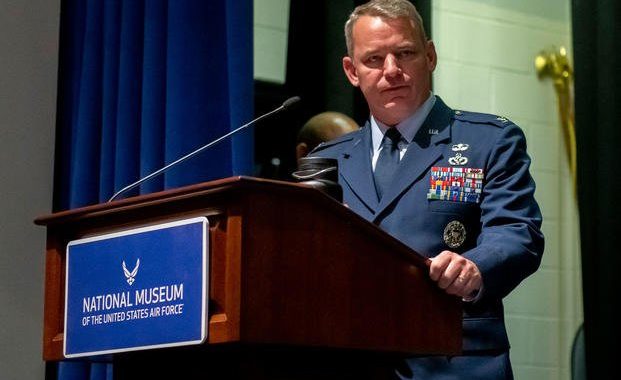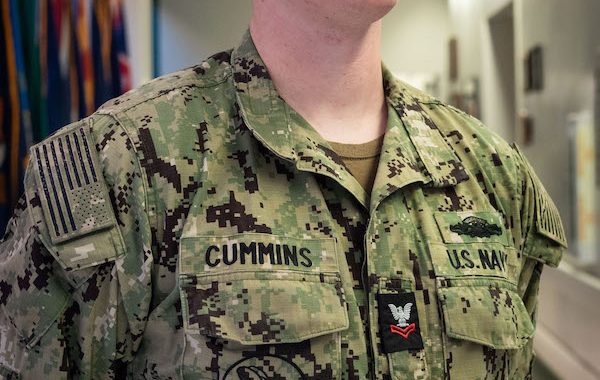Reports of sexual assaults increased in Navy, Air Force and Marines in 2022; Army saw decline
4 min read
Sailors assigned to the amphibious assault ship USS Wasp pose in April 2022 in Norfolk, Va., for a photo on a pier at BAE Systems Shipyard. Sailors stood in the shape a ribbon while holding teal paper to show support for sexual assault victims.
WASHINGTON — The latest assessment by the Defense Department of sexual assaults in the military shows only a slight increase in incidents across the armed forces in 2022, with the Army reporting a decline in assaults.
The Pentagon on Thursday released its Annual Report on Sexual Assault in the Military, which shows a roughly 1% increase in overall reports of sexual assaults in fiscal 2022. Eight months ago, the military’s 2021 report showed a 13% increase across the entire force.
However, defense officials contend an increase of sexual assault reports is a positive step toward addressing the problem.
“We are encouraged to see greater reporting because it means that our sexual assault victims are getting the care and advocacy they need,” said Elizabeth Foster, director of the Office of Force Resiliency for the undersecretary of defense for personnel and readiness. “And it creates opportunities for accountability through the military justice process.”
There were 8,942 reports of sexual assault across the Army, Navy, Air Force and Marine Corps in 2022, according to the report. Of those, almost 7,400 came from troops who said the assault occurred during military service, which is also a slight increase from last year.
The military-wide increase in reports for 2022 would have been greater if not for the Army’s decrease in reported sexual assaults. The Pentagon data show reported incidents among Army soldiers last year was down 9% compared to 2021, when the service saw a massive 26% rise in reported assaults.
Meanwhile, reported assaults in the other three services were up. The Air Force saw the greatest increase in 2022 — 13% — while the Navy had a 9% increase in reports and the Marine Corps a 3.6% rise. In 2021, the Navy also saw a 9% increase in reports, while the Air Force and Marine Corps each saw rises of roughly 2%.
The Pentagon tracks sexual assaults using two metrics — the prevalence rate and the reporting rate. The reporting rate is the figure outlined by Thursday’s assessment. The prevalence rate is an estimate of how many sexual assaults occurred in the military, which is derived from a separate report the Pentagon releases every two years. Officials said the prevalence report is a more accurate picture of how many sexual assaults are occurring in the military because the reporting is confidential.
The military’s most recent prevalence report, issued last year, showed an estimated number of 36,000 reports of unwanted sexual contact.
“This is a really high-level snapshot of the significant work that is underway at the department,” Foster said of Thursday’s report. “We know [change] isn’t going to happen overnight. If we could flip a switch and make this change instantly, we would, but we know this is going to take some time.”
The issue of sexual assaults in the armed forces has been a serious problem for several years as reports have risen and various military efforts have been drawn up to counter the upward trend. Congress has repeatedly complained about the rising numbers of assaults and has asked the Pentagon to get to the bottom of the issue. Sen. Jack Reed, D-R.I., chairman of the Senate Armed Services Committee, last year called the problem of sexual assaults in the military a “scourge.”
The Pentagon said this year’s report partly focuses on implementing dozens of recommendations from the Independent Review Commission — a panel set up by Defense Secretary Lloyd Austin two years ago to “drive meaningful change in how the armed forces prevent, respond to and ensure accountability for sexual assault and sexual harassment.”
Of the 82 recommendations that the group issued in its 2021 study, the Pentagon said it has implemented 21 of them, including development of a “dedicated prevention workforce” and introducing programs that allow victims to take more time off and receive additional support services. Another effort underway will create the Offices of Special Trial Counsel by the end of this year.
The Offices of Special Trial Counsel in each service will be comprised of independent prosecutors. Instead of relying on military commanders to manage prosecutions, the independent prosecutors will now handle sexual assault cases. The idea is to remove command influences and biases from the legal process and restore troops’ faith that military justice is fair, evidence-based and impartial, according to the report.
Congress has given the Pentagon $479 million this year to implement the commission’s recommendations, and the military’s 2024 budget proposal asks for $636 million to do so next year, defense officials said.
“That’s hugely significant because that really put a huge monetary investment behind the program,” Foster said. “Which is, frankly, something that has been missing.”
Thursday’s report also stipulates commanders had enough evidence to take disciplinary actions in roughly 2,100 sexual assault cases under military jurisdiction in 2022. About 1,500 warranted a sexual assault charge and almost 40% of those were referred for courts-martial. The data states about 75% of the sexual assault court-martials last year ended in a conviction.
Next year’s sexual assault report will once again include prevalence estimates from the Pentagon’s confidential survey and an update on how the military is complying with the remaining 61 commission recommendations.
“Our national military strategy depends upon a lethal, resilient, and agile joint force,” Nate Galbreath, acting director of the Pentagon’s Sexual Assault Prevention and Response Office. “Our initiatives this year empowered leaders to identify threats to readiness and restore the health of both their units and service members impacted by sexual assault and other misconduct. We are on track to make the reforms and investments necessary to counter sexual assault in the military.”





